theartsdesk at the Dresden Music Festival - orchestral abundance in a spectacular setting | reviews, news & interviews
theartsdesk at the Dresden Music Festival - orchestral abundance in a spectacular setting
theartsdesk at the Dresden Music Festival - orchestral abundance in a spectacular setting
The Saxon city’s world-famous orchestras front and centre in a full programme of events
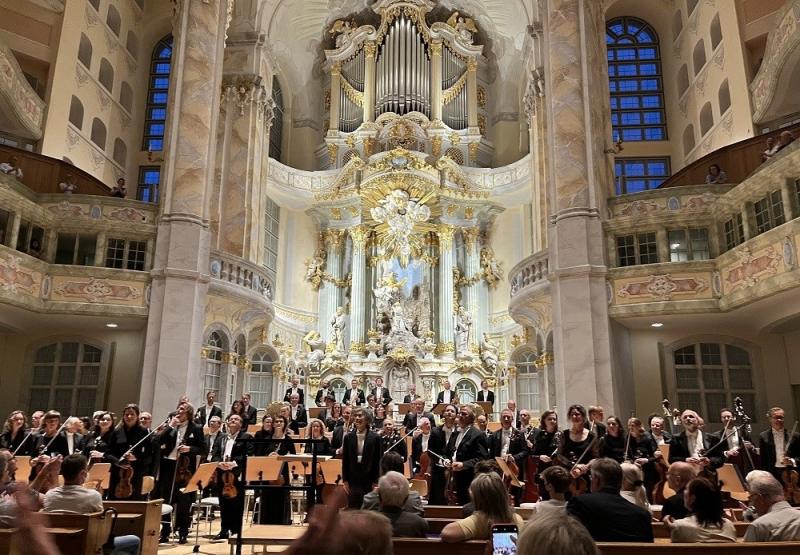
Dresden is filled with music at this time of year. The Dresden Music Festival runs through May and early June, with concerts at all the famous venues – the Frauenkirche, the Semperoper – but also recitals in smaller halls and unlikely settings.
My visit also coincided with the Dresden Dixieland Festival. This is a huge outdoor event, with stages in each of the city’s historic squares. Walking through the Baroque streets, you find your footsteps synchronising with a gently persuasive bass line from some distant Sousaphone. Then you’ll turn a corner and be confronted with the abrasive tone of an overamplified banjo solo. Standard attire is a straw boater and thick red braces.
But go into any of the festival venues, and you will find a more formal atmosphere – everything is relaxed and friendly, but classical audiences here still like to dress smart. The Dresden Music Festival has been going since 1978. It was originally founded by the GDR government, but has transitioned successfully as times changed. Since 2009, the artistic director has been cellist Jan Vogler. He is an ideal fit for both the festival’s local character and its international aspirations. Vogler (pictured below in concert by Oliver Killig) grew up in East Berlin, and at 20 became the principal cellist of the Staatskapelle Dresden. Soon after reunification, he moved to New York to pursue a solo career. He is still based in the States, but regularly returns. In 2005 he performed at the official opening of the restored Frauenkirche. 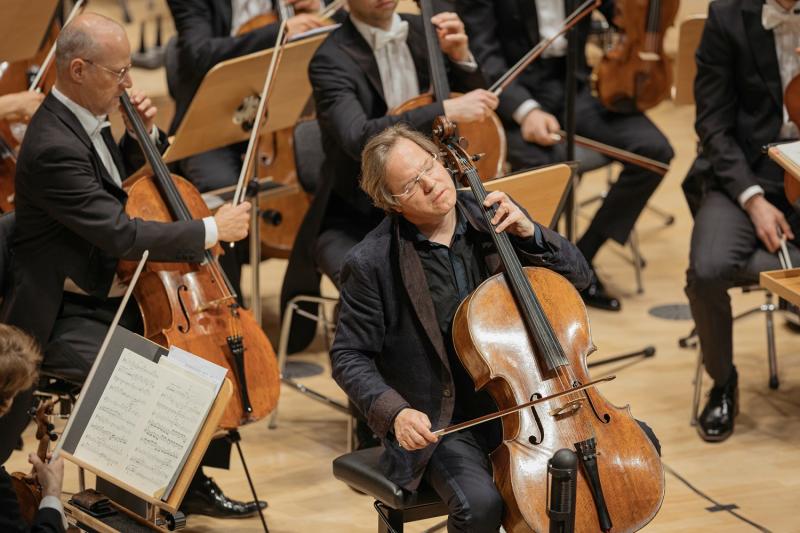
This weekend sampling began with the Dresden Philharmonic performing at the Frauenkirche (pictured above). On paper, Kent Nagano’s programme seemed random and diffuse: Ives’ The Unanswered Question, a short percussion work by Toshio Hosokawa and Bruckner’s Sixth Symphony. But on entering the church, his thinking made perfect sense. The acoustic here is unique. That huge, imposing cupola swallows up the sound and then returns it to you in a gradual, even reverb. It is a clean and unfussy decay, just very, very long. Each of these works had been chosen to fill the space, to communicate through the venue rather than compete against it.
The Unanswered Question was a perfect choice. Ives envisaged a small string ensemble, but the full string section of the Dresden Philharmonic, playing at the quietest dynamics and with minimum vibrato, proved mesmerising. The solo trumpet (unmuted) was high up in one of the galleries. His sound was taken up into the cupola and distributed evenly around the church – he could have been anywhere. The Hosokawa Intermezzo is taken from his recent opera Stilles Meer, about the 2011 tsunami in Japan. It consists of four percussionists playing large, untuned drums plus tam tam. They produce waves of sound, an almost literal depiction of the opera’s subject. Those waves rolled around the space effectively here. 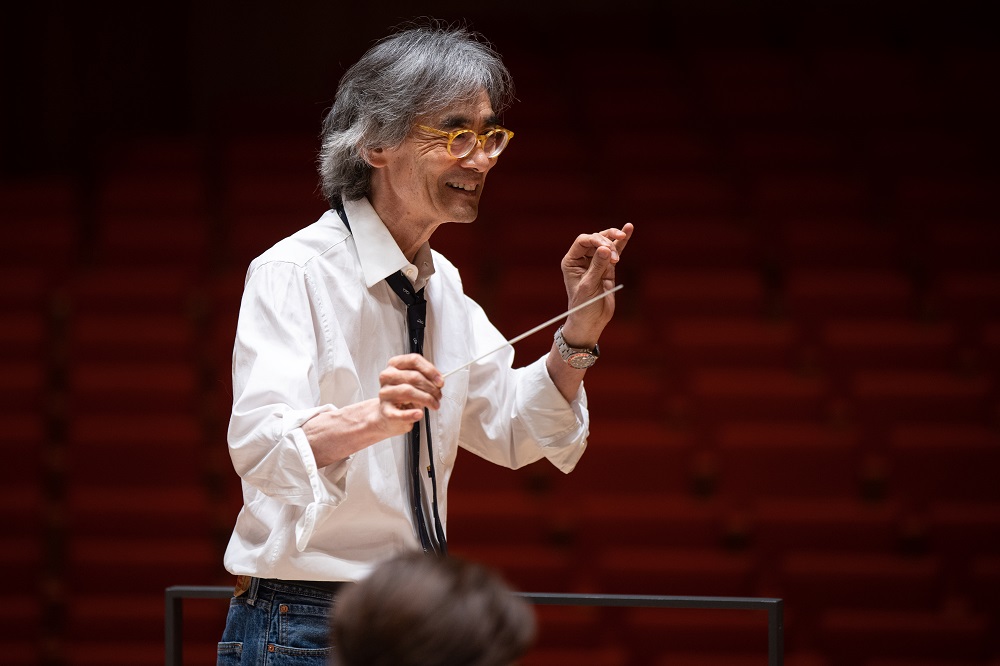 Nagano (pictured above in rehearsal by Bjoern Kadenbach) has performed much Bruckner, in Munich, Dresden and Berlin, but many listeners have had reservations. His tempos can be erratic, with little sense of flow from one idea to the next. That was the case in this performance too, but it had some redeeming moments. Nagano is usually on the fast side with Bruckner, and he made no concessions to the acoustic. Some details were lost, especially in the woodwinds. The payoff was increased dramatic weight, with the warm, round sound of the strings and brass filling the church and embracing the audience. The most effective movement was the Adagio. Here, Nagano maintained an even, slow pace. Again, the warm string tone provided a lush bed of sound, over which the woodwind soloists could phrase freely.
Nagano (pictured above in rehearsal by Bjoern Kadenbach) has performed much Bruckner, in Munich, Dresden and Berlin, but many listeners have had reservations. His tempos can be erratic, with little sense of flow from one idea to the next. That was the case in this performance too, but it had some redeeming moments. Nagano is usually on the fast side with Bruckner, and he made no concessions to the acoustic. Some details were lost, especially in the woodwinds. The payoff was increased dramatic weight, with the warm, round sound of the strings and brass filling the church and embracing the audience. The most effective movement was the Adagio. Here, Nagano maintained an even, slow pace. Again, the warm string tone provided a lush bed of sound, over which the woodwind soloists could phrase freely.
The following day, Dresden’s other main orchestra, the Staatskapelle, performed at its home, the Semperoper (the concert pictured below), and under its chief conductor, Christian Thielemann. Like the Philharmonic concert, this was part of the orchestra’s main season, and had been co-opted into the festival. Vogler explains, "I want the local orchestras to be part of the Festival. That way, visitors can understand that Dresden is a musical town. The Festival is both a window to look into Dresden, and a window to look out." Thielemann fosters a traditional eastern German sound – warm, rich strings; characterful but blended winds – and sticks to the core Austro-German repertoire. 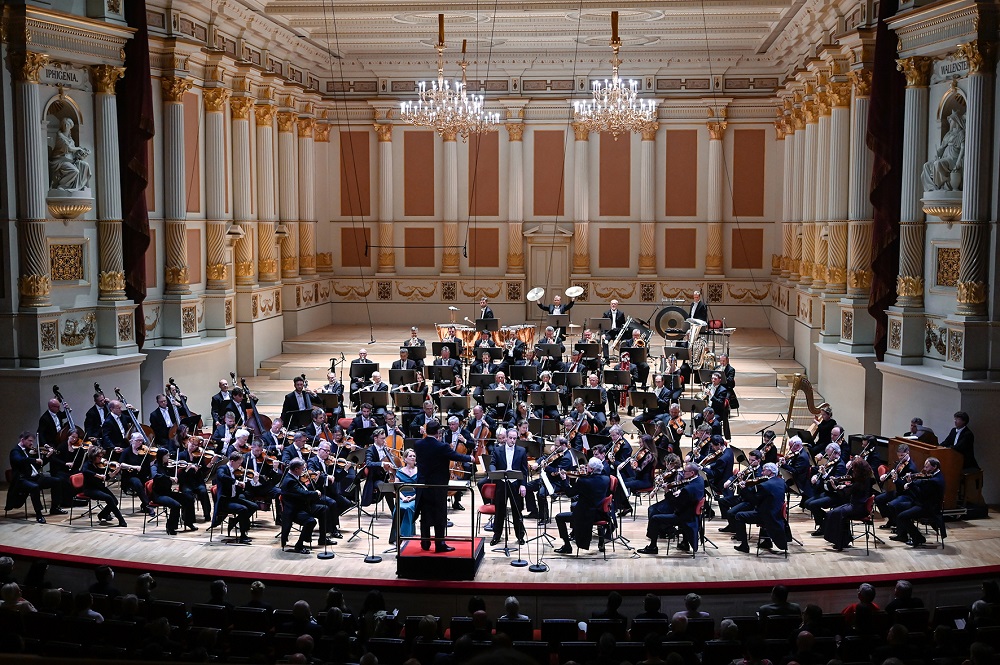 To open, Mendelssohn’s "Scottish" Symphony, No. 3. Thielemann’s big sound is attractive in Mendelssohn, and sets him apart from the slicker, period-inspired approach that has become the convention. As with everything he conducts, Thielemann makes it his own. His feeling for the long line works as well in Mendelssohn as it does in Wagner. The slow introduction to the first movement here played out as a single, coherent statement. In the faster sections, the weight of tone and steady tempos were balanced effectively by incisive and varied articulation from the woodwinds. Thielemann is performing all the Mendelssohn symphonies next season, and a recording of the cycle can be expected. The microphones were out for this performance, so this will probably be included.
To open, Mendelssohn’s "Scottish" Symphony, No. 3. Thielemann’s big sound is attractive in Mendelssohn, and sets him apart from the slicker, period-inspired approach that has become the convention. As with everything he conducts, Thielemann makes it his own. His feeling for the long line works as well in Mendelssohn as it does in Wagner. The slow introduction to the first movement here played out as a single, coherent statement. In the faster sections, the weight of tone and steady tempos were balanced effectively by incisive and varied articulation from the woodwinds. Thielemann is performing all the Mendelssohn symphonies next season, and a recording of the cycle can be expected. The microphones were out for this performance, so this will probably be included.
Thielemann’s feeling for line and texture, and his experience in Wagner, make him a natural for Zemlinsky’s Lyric Symphony. The work is a setting for baritone and soprano of texts by Rabindranath Tagore, the style somewhere between Das Lied von der Erde and Gurrelieder. In lesser hands it can sound protracted and listless, but the rich colours that Thielemann draws from the Staatskapelle, combined with the sense of purpose in his phasing, elevates the music. Christian Gerhaher was replaced at short notice by Adrian Eröd. That seemed like a poor trade, but in the event, Eröd was fully up to the huge demands of the score. His operatic delivery was incisive and clear, with plenty of tonal character. Soprano Julia Kleiter was less impressive. She is given a harder time by Zemlinsky, but was often defeated by the huge orchestra.
Next, a visiting orchestra, the Frankfurt Radio Symphony under conductor laureate Paavo Järvi (pictured below by Oliver Killig). Jan Vogler chose the orchestra and conductor specifically for his own performance of the Dvořák Cello Concerto, the centrepiece of Cellomania 2.0. That might seem like a curious choice: Vogler, coming from eastern Germany, grew up in the performing tradition exemplified by the Dresden Philharmonic and the Staatskapelle. So why perform with an orchestra and conductor known for their clean, analytical approach? Vogler explains, "My sound changed because I moved to America. I wanted it to. You have to open yourself up to influences, and when you do you never lose yourself. I grew up in East Germany, so, as you can imagine, my feeling was, 'I want air!’. I chose the Frankfurt Radio Orchestra and Parvo because with this piece it is good to have a conductor who is interested in shape and form, otherwise it can become too elaborate." 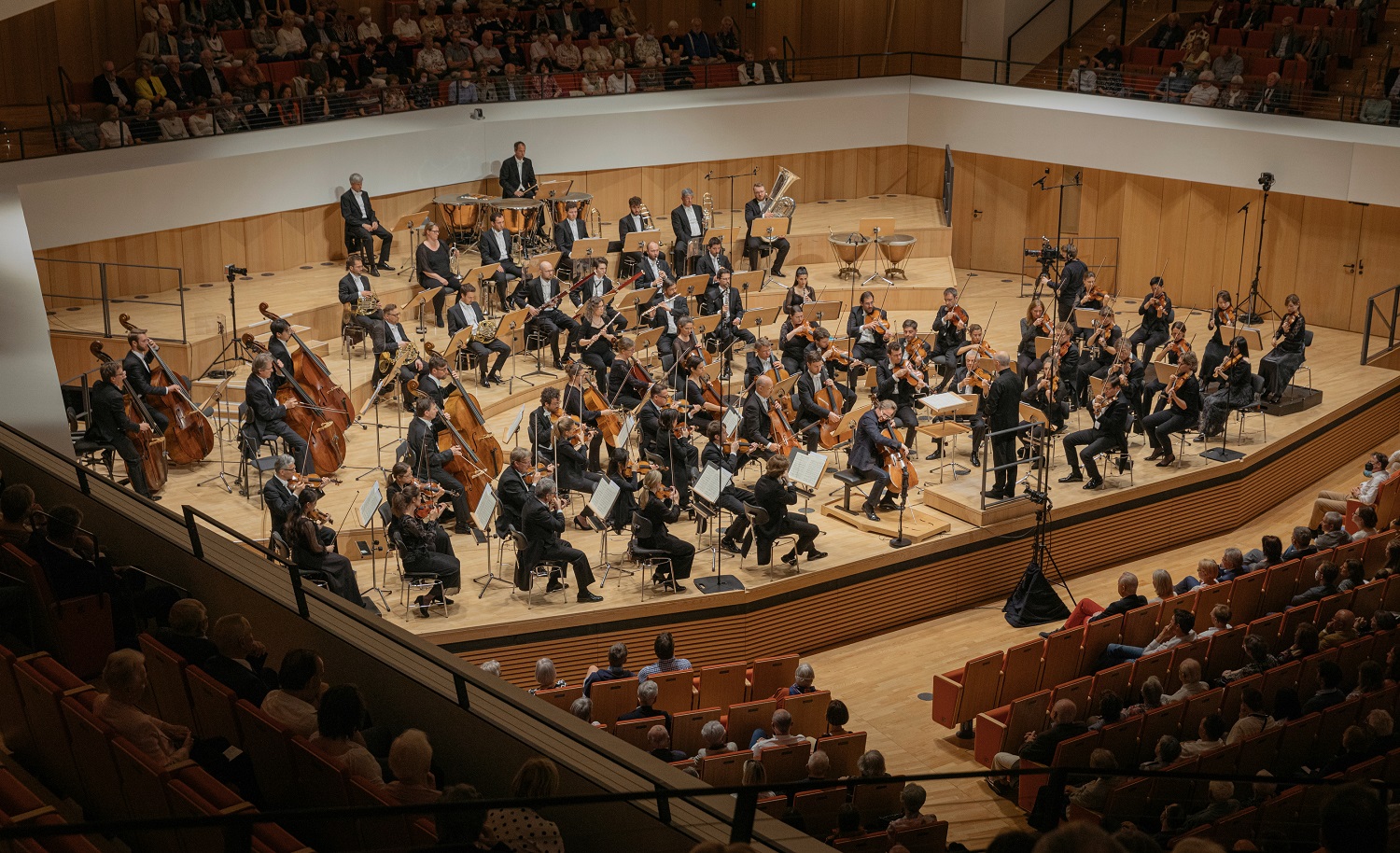
The performance took place in the communist-era Kulturpalast, a monstrously out-of-place GDR Plattenbau on the outside (with listed artwork, pictured below), and an elegant and acoustically refined vineyard-style concert hall on the inside. Vogler’s tone and expression are focused and direct, with some warmth, but little of the eastern German richness and weight. His take on the Dvořák was discursive and poetic, with lyrical flair, but without any faux gravitas or excessive theatre. The Frankfurt Orchestra sounded clean and precise, and Vogler’s duets, with the solo flute and violin, came off as conversations between equals. 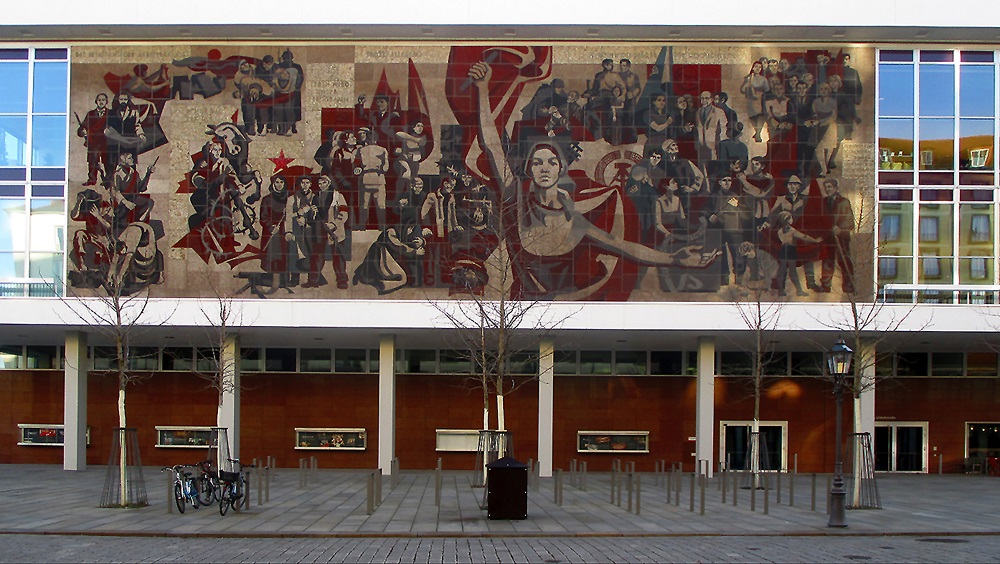 Järvi concluded with Beethoven’s Eighth Symphony. The conductor’s "interest in shape and form" proved particularly valuable here. Beethoven follows the traditional symphonic structure, yet his music always seems to be pulling against the obligations of the form. Järvi projected this tension beautifully, making significant interventions at points that would otherwise be structurally insignificant and often overriding the big climaxes and cadences. The endings of the first and second movements seemed almost accidental, irrelevant to the composer’s train of thought. Tempos were generally fast, but that was more than justified by the clarity of texture. Some moments of shaky ensemble from the woodwinds and brass betrayed the fact that this orchestra is not at the same level of excellence as those in Dresden, but the collective passion and uniformity of intent ensure a similarly distinctive sound.
Järvi concluded with Beethoven’s Eighth Symphony. The conductor’s "interest in shape and form" proved particularly valuable here. Beethoven follows the traditional symphonic structure, yet his music always seems to be pulling against the obligations of the form. Järvi projected this tension beautifully, making significant interventions at points that would otherwise be structurally insignificant and often overriding the big climaxes and cadences. The endings of the first and second movements seemed almost accidental, irrelevant to the composer’s train of thought. Tempos were generally fast, but that was more than justified by the clarity of texture. Some moments of shaky ensemble from the woodwinds and brass betrayed the fact that this orchestra is not at the same level of excellence as those in Dresden, but the collective passion and uniformity of intent ensure a similarly distinctive sound.
The concert played to a capacity audience at the sizable Kulturpalast, and the previous events were also well attended: a triumph for the Festival’s marketing team. Until shortly before opening night, government restrictions meant that they were planning for events with much reduced, socially distanced audiences. But a surprise announcement late in March reversed that decision, meaning that 20,000 more tickets suddenly became available. And they have been selling fast, both to local audiences and to the many tourists who have returned to the historic city. The message from this year’s festival is clear: live music in Dresden is back.
rating
Share this article
The future of Arts Journalism
You can stop theartsdesk.com closing!
We urgently need financing to survive. Our fundraising drive has thus far raised £49,000 but we need to reach £100,000 or we will be forced to close. Please contribute here: https://gofund.me/c3f6033d
And if you can forward this information to anyone who might assist, we’d be grateful.

Subscribe to theartsdesk.com
Thank you for continuing to read our work on theartsdesk.com. For unlimited access to every article in its entirety, including our archive of more than 15,000 pieces, we're asking for £5 per month or £40 per year. We feel it's a very good deal, and hope you do too.
To take a subscription now simply click here.
And if you're looking for that extra gift for a friend or family member, why not treat them to a theartsdesk.com gift subscription?
more Classical music
 theartsdesk at the Three Choirs Festival - Passion in the Cathedral
Cantatas new and old, slate quarries to Calvary
theartsdesk at the Three Choirs Festival - Passion in the Cathedral
Cantatas new and old, slate quarries to Calvary
 BBC Proms: Estonian Philharmonic Chamber Choir, Kaljuste review - Arvo Pärt 90th birthday tribute
Stillness and contemplation characterise this well sung late-nighter
BBC Proms: Estonian Philharmonic Chamber Choir, Kaljuste review - Arvo Pärt 90th birthday tribute
Stillness and contemplation characterise this well sung late-nighter
 BBC Proms: Kholodenko, BBCNOW, Otaka review - exhilarating Lutosławski, underwhelming Rachmaninov
Polish composers to the fore in veteran conductor’s farewell
BBC Proms: Kholodenko, BBCNOW, Otaka review - exhilarating Lutosławski, underwhelming Rachmaninov
Polish composers to the fore in veteran conductor’s farewell
 theartsdesk at the Pärnu Music Festival 2025 - Arvo Pärt at 90 flanked by lightness and warmth
Paavo Järvi’s Estonian Festival Orchestra still casts its familiar spell
theartsdesk at the Pärnu Music Festival 2025 - Arvo Pärt at 90 flanked by lightness and warmth
Paavo Järvi’s Estonian Festival Orchestra still casts its familiar spell
 BBC Proms: Batsashvili, BBC Scottish Symphony Orchestra, Ryan Wigglesworth review - grief and glory
Subdued Mozart yields to blazing Bruckner
BBC Proms: Batsashvili, BBC Scottish Symphony Orchestra, Ryan Wigglesworth review - grief and glory
Subdued Mozart yields to blazing Bruckner
 Classical CDs: Hens, Hamburg and handmaids
An unsung French conductor boxed up, plus Argentinian string quartets and baroque keyboard music
Classical CDs: Hens, Hamburg and handmaids
An unsung French conductor boxed up, plus Argentinian string quartets and baroque keyboard music
 BBC Proms: McCarthy, Bournemouth SO, Wigglesworth review - spring-heeled variety
A Ravel concerto and a Walton symphony with depth but huge entertainment value
BBC Proms: McCarthy, Bournemouth SO, Wigglesworth review - spring-heeled variety
A Ravel concerto and a Walton symphony with depth but huge entertainment value
 BBC Proms: First Night, Batiashvili, BBCSO, Oramo review - glorious Vaughan Williams
Spirited festival opener is crowned with little-heard choral epic
BBC Proms: First Night, Batiashvili, BBCSO, Oramo review - glorious Vaughan Williams
Spirited festival opener is crowned with little-heard choral epic
 Interview: Quinteto Astor Piazzolla on playing in London and why Mick Jagger's a fan
Music Director Julián Vat and pianist Matias Feigin compare notes on Piazzolla
Interview: Quinteto Astor Piazzolla on playing in London and why Mick Jagger's a fan
Music Director Julián Vat and pianist Matias Feigin compare notes on Piazzolla
 Classical CDs: Bells, birdsong and braggadocio
British contemporary music, percussive piano concertos and a talented baritone sings Mozart
Classical CDs: Bells, birdsong and braggadocio
British contemporary music, percussive piano concertos and a talented baritone sings Mozart
 Siglo de Oro, Wigmore Hall review - electronic Lamentations and Trojan tragedy
Committed and intense performance of a newly-commissioned oratorio
Siglo de Oro, Wigmore Hall review - electronic Lamentations and Trojan tragedy
Committed and intense performance of a newly-commissioned oratorio

Add comment